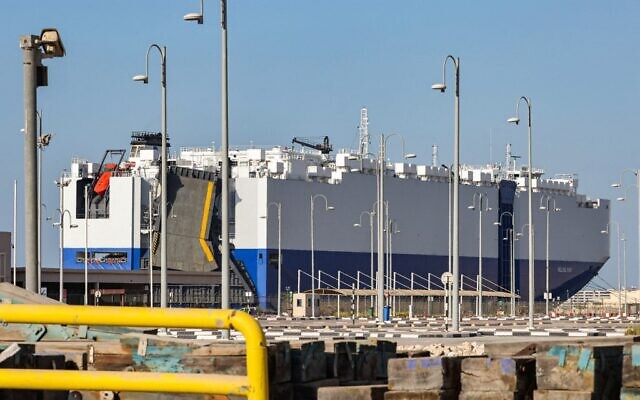Jerusalem appears to be wading deeper into a water fight with Tehran in the Red Sea, while remaining vulnerable in the Persian Gulf, with no guarantees the US will dive in to help
By LAZAR BERMAN
Today, 11:04 pm

A suspicious boat off the stern of the Iranian ship ‘Saviz’ in the Red Sea in 2018. (Al Arabiya video screenshot/File)
In early March, after an Israel-owned ship was damaged by limpet mines in the Gulf of Oman, The Times of Israel wrote that “Israel could send its own message by targeting an Iranian ship in the Red Sea, such as the Saviz.”
Last Tuesday, Israel is believed to have done just that, attacking that very Iranian vessel, with mines of its own, according to reports.
As detailed in that story a month ago, “since 2017, the Saudis have alleged the Saviz served as a maritime base and weapons transshipment point for the [Islamic Revolutionary Guards Corps].”
Get The Times of Israel’s Daily Edition by email and never miss our top storiesFREE SIGN UP
In many ways, the Saviz was the perfect target. After the covert maritime struggle between Israel and Iran burst into the open this year, with Tehran displaying new audaciousness in its attacks on Israeli-owned vessels, Israel had to respond in a way that would send a clear message.
But in so doing, Israel risks getting in a fight in which it has some glaring vulnerabilities. It also runs the danger of irritating a US administration intent on restarting nuclear talks with Iran, negotiations that could be scuppered, should the struggle between Iran and its regional foes heat up.
The IRGC mothership
The Saviz, anchored in international waters just off Eritrea’s Dahlak archipelago, lay vulnerable and relatively close to Israel. In that regard, it was an obvious choice as a target.
This October 1, 2020, satellite photo from Planet Labs Inc. shows the Iranian cargo ship MV Saviz in the Red Sea off the coast of Yemen. (Planet Labs Inc. via AP)
The vessel – formerly known as the Azalea, Iran Ocean Candle, Lantana, and Ocean Candle — was initially put under sanctions by the US government, but was removed from the list of designated vessels on January 16, 2016, the day the 2015 JCPOA nuclear deal went into effect. In April 2020, the Treasury Department announced that the Saviz was back on the list.
The “mothership,” as described in a Washington Institute report, came to public attention in 2017, when the Saudi-led Arab Coalition fighting Iran-backed Houthi rebels in Yemen released a dossier showing uniformed personnel on the ostensibly civilian vessel. Coalition spokesman Col. Turki Al-Maliki accused the Saviz of supporting Houthi naval attacks. In 2018, the Saudi-owned Al Arabiya channel aired footage of the ship, as well as Boston Whaler-type speedboats on deck, typically used by the Iranian Revolutionary Guards Corps Navy.
“It has been equipped with four 50-caliber machine guns that have been hidden by the ships’ crew…” alleges the report. “It also has a satellite and highly-developed military communications system.” Al Arabiya cameras captured one of the speedboats transferring equipment from a passing Iranian ship to the Saviz.
The ship drew the ire of locals as well. In November 2018, fishermen in the Yemeni city of Taiz staged a protest against the Saviz, calling it a threat to their well-being, according to local reports.
The vessel has been anchored a few miles from the narrow Bab al-Mandeb straits at the southern end of the Red Sea since 2017, and has barely moved since then, according to reports based on maritime tracking technology.
“It’s more like a platform, a floating island, a barge, than a ship,” said Steffan Watkins, a private open-source defense researcher based in Canada.
Based on its location, the Saviz can keep a close eye on ships – including Israeli vessels – sailing through the key shipping lane, and is also well-positioned to play a supporting role in attacks on tankers, allegedly by Iranian proxies, that have taken place in the area.
The Saviz certainly isn’t the only ship lurking around the Bab al-Mandeb.
“That area has a lot of ships that drop anchor and hang out,” said Watkins, especially private military company vessels that accompany cargo ships through the dangerous waters.
“By international law, they’re in international waters, so no one can tell them to go away,” said Watkins, who began examining the Saviz in 2017. “They can be blown up, but they can’t legally be evicted from that location.”
On Sunday, private satellite photography analysis firm ImageSat International released a picture of the Iranian ship taken earlier in the day, showing that it had not moved since the attack and remained anchored in the Red Sea, between Yemen and Eritrea.
Deterrence and its limits
The alleged attack on the Saviz is the latest incident in a simmering gray zone conflict between Israel and Iran.
“Gray zone operations” are coercive, ambiguous actions taken by actors trying to upend the regional order while staying below the threshold that would justify a military response by stronger parties. NATO militaries have increasingly recognized them as a challenge.
Experts believe the gray zone approach is a central component of Iran’s national security strategy. Deniable attacks on civilian shipping fit into Iran’s broader, asymmetric naval strategy.
An attack that makes attribution difficult “creates ambiguity that serves Iran’s interests,” said Anthony Cordesman, the Arleigh A. Burke Chair in Strategy at the Washington, DC-based Center for Strategic and International Studies. “If you can use gray zone operations to achieve your objectives without escalating to more serious conflict, these kinds of operations offer you advantages and a level of security that higher intensity combat doesn’t. And Iran has practiced a very wide range of attacks.”
Israeli soldiers survey the border with Syria from a military post in the Golan Heights, following a series of aerial clashes with Syrian and Iranian forces in Syria, on February 10, 2018. (Flash90/File)
Part of that campaign is unfolding on Israel’s doorstep. While Syria is consumed by a decade-long civil war, Iran has been trying to open a new front on the border. It has sent allied forces to the Syrian Golan Heights to set up infrastructure for carrying out attacks on Israeli targets. Iran has also been working to arm its Hezbollah proxy terrorist group with precision rocket capabilities, shipping weapons through Syria to Lebanon.
However, Israel has displayed competence in sniffing out Iranian actions and a firm willingness to disrupt them using military force. Israel’s air force has launched hundreds, even thousands, of strikes against Iran and its proxies in Syria and Iraq since 2011.
There has been naval theater in this struggle as well, though it only came to light recently. In March, the Wall Street Journal reported that Israel has targeted at least 12 ships bound for Syria, most of them transporting Iranian oil, with mines and other weapons, starting in late 2019.
The Israeli-owned Bahamian-flagged MV Helios Ray cargo ship docked in Dubai’s Mina Rashid (Port Rashid) cruise terminal, on February 28, 2021. (Giuseppe CACACE / AFP)
In likely retaliation, Iran reportedly struck two Israeli-owned ships in March, both in the Gulf of Oman.
An Israeli response in the Red Sea seems entirely plausible, said Yaakov Amidror, former national security advisor and senior fellow at the Jerusalem Institute for Strategic Studies.
“It’s a range in which Israel knows how to operate,” he told The Times of Israel.
The attack, if Israel was behind it, also makes strategic sense, he argued. “The endgame is to make it clear to the Iranians that they cannot strike civilian ships that have a connection to Israel that haven’t violated any international law,” he said. “And if they continue to do that, then Israel knows how to operate very from its borders.”
“It’s an area that we don’t want to stop sailing in… The Iranians should know that there’s a price for these types of actions,” he added.
Former Israeli national security adviser Yaakov Amidror (Flash90)
Others aren’t so sanguine about the operation. “Even though on the operational level, this is fascinating, but trying to evaluate what the strategic goal is, I’m not sure it’s defined well,” said Prof. Shaul Chorev, head of the University Of Haifa’s Maritime Policy & Strategy Research Center. “It might be some kind of deterrence to the IRGC not to attack again an Israeli ship.”
But deterrence is not an easy goal to achieve or even measure. While Israel’s operations in Syria seem to have forced decision-makers in Tehran to accept that they would be wise to avoid attacking Israeli soldiers and infrastructure from across the border, the Persian Gulf and Gulf of Oman are different stories entirely. Israel has little capacity – beyond submarines — to project power there, while Iran has invested heavily in pursuing hegemony over the seas in its neighborhood, which includes the Strait of Hormuz, a shipping lane no less important than the Bab el-Mandab.
“The experience that we have is that the Iranians are not hesitating to escalate in an area where the Israeli navy has no capability to operate,” said Chorev, a former deputy chief of the Israel Navy.
Iran will “definitely” respond to a recent attack on an Iranian ship in the Red Sea, a spokesman for the Islamic Republic’s military said last week.
Splitting the seas
Israel cannot put its soldiers on Israeli civilian ships in the Persian Gulf, as they could be captured by Iran. The most promising avenue for Israel is to seek some sort of security guarantees by the US and Arab Gulf states to protect Israeli shipping. The Pentagon’s January decision to include Israel in its Central Command will make it easier for the Jewish state to work closely with the US Fifth Fleet and its Arab partners in the Persian Gulf.
A centerpiece of Israel’s normalization with the Gulf states was increased trade, especially with the global shipping hub of Dubai. If Israel is not careful, it might cause an escalation that leads to increased attacks where Iran knows Israel is quite vulnerable.
“This situation endangers other Israeli civilian ships, and the fear is that the Iranians will try to strike other vessels. Someone must take this into consideration,” a defense official told Walla! news.
The balance of power between Israel and Iran in the Red Sea, where the Saviz is anchored, is much more even. Israel’s Eilat naval base is closer to the Red Sea theater than the nearest Iranian base, but Iranian-backed Houthi rebels control coastline and islands near the Bab al-Mandeb straits. The Houthis have targeted civilian and military ships from their bases there.
An Israeli Navy boat escorts the cargo vessel Klos C (left) into the Israeli port of Eilat. (Flash90)
The Red Sea is a difficult area for any navy to operate in. Its narrow sea lanes mean ships sail near each other and near the coastline of countries like Egypt, Sudan, Eritrea, and Yemen, which have all struggled to impose control over swathes of their territory. Ships sailing through the Red Sea are easy for governments and rebel groups to track in real-time.
Still, some believe that in light of the Iranian threat and the burgeoning trade relationship with Gulf countries, Israel must improve its capabilities in the Red Sea.
“I think the Navy should move its center of activity from the Mediterranean to the Red Sea,” said Chorev.
That task is more complex than it may seem. In addition to the proximity to hostile groups like the Houthis, Israel must gain permission from Egypt every time it wants to move ships from the Mediterranean Sea to the Red Sea by sailing a naval vessel through the Suez Canal.
“It’s not easy to operate in this area,” stressed Chorev. “Nevertheless we have to operate there.”
The war over the war
The same day that the attack on the Saviz was carried out, US and Iranian negotiators carried out indirect talks in Vienna to seek a way back to the 2015 Joint Comprehensive Plan of Action, better known as the Iran nuclear deal.
Some Israeli outlets suggested that Israel timed its operation to coincide with the Vienna talks, possibly as a message to either Washington or its Arab partners that it would continue to operate against Iranian threats.
Deputy Secretary General and Political Director of the European External Action Service (EEAS), Enrique Mora, right, leaves the Grand Hotel Wien where closed-door nuclear talks with Iran take place in Vienna, Austria, April 6, 2021. (AP Photo/Florian Schroetter)
Amidror dismissed that notion out of hand. “That’s media nonsense, come on. An operation like this takes two or three weeks to prepare, no one knew what the date of the meeting would be.”
But there could be a different connection to the nuclear talks. The Saviz attack came to light through an American leak to The New York Times. By revealing the incident, the Biden administration may well have been sending a message to Israel that it disapproves of such operations while it is trying to find a formula that will allow it to rejoin the nuclear deal.
Israel, it appears, is not backing down. On Sunday morning, word came of another mysterious attack, this time what appeared to be a cyber assault sabotaging the Natanz nuclear plant.
Officially Israel has remained mum, but by Sunday evening, leaks were reaching Hebrew-language media from unidentified intelligence sources — not US officials to a US outlet — that Israel’s Mossad intelligence agency was responsible for the attacks, what may have been intended as an Israeli message back to the Biden administration that it will not be cowed by Washington’s pre-nuclear talks shushing.
Israel’s foe, though, is not in Washington, but in Tehran, and if it wants to deter Iran and feel safe sailing through the Middle East, it will likely need to find a way to work with the Biden administration and quit rocking the boat.

